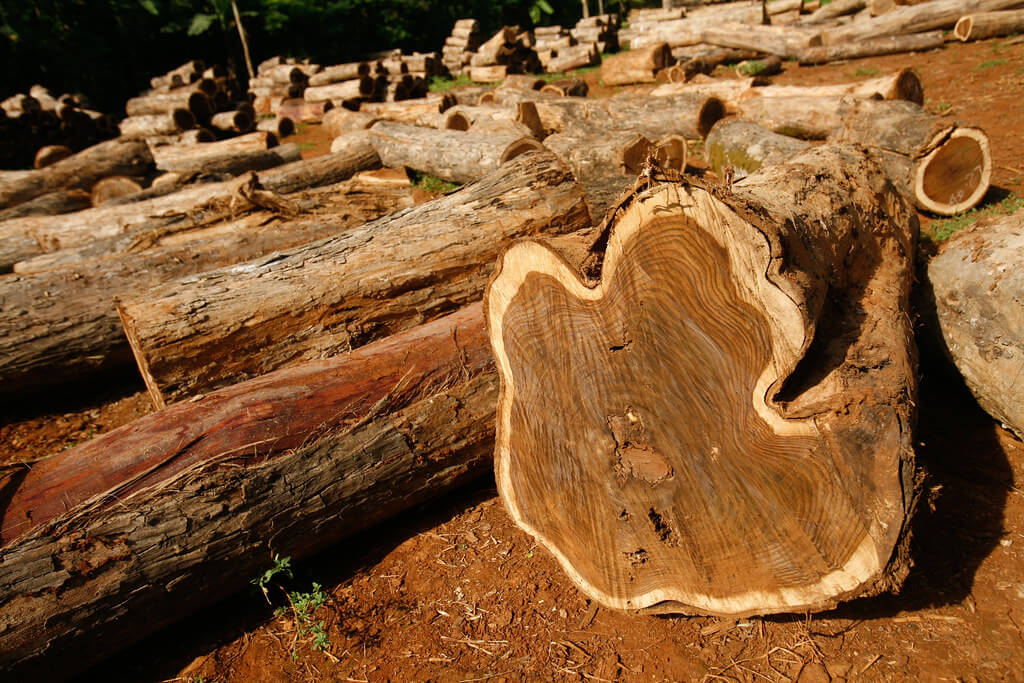Dandeli, a town in the Uttara Kannada district of Karnataka, India, is well-known for its forests, which include significant teak plantations. Dandeli teak wood, often referred to as North Kanara teak or Godavari teak, is highly regarded for its unique qualities.

Here’s a detailed overview of Dandeli Teak wood:
Characteristics:
- Origin: Primarily thrives in the fertile soils of northern Karnataka, with Dandeli as a key cultivation area. The region’s soil is rich in essential tertiary minerals like silicates, manganese, mica, and iron, which contribute to the wood’s distinctive properties.
- Color and Grain: It typically has a golden-brown color that darkens over time to a warm, honey-like hue. It exhibits straight grains with irregular spirals, giving it an elegant appearance.
- Strength and Durability: Dandeli teak wood is highly prized for its exceptional strength and toughness, often compared to Burma teak. Its high density contributes to its structural integrity and longevity.
- Natural Resistance: One of its most significant attributes is its natural resistance to decay, rot, and insects (like termites). This is due to its high natural oil and rubber content, which act as built-in weatherproofing agents.
- Moisture Resistance: It demonstrates remarkable resistance to dampness and can withstand exposure to various weather conditions without warping, cracking, or rotting.
- Workability: Despite its strength, teak wood is relatively easy to work with, allowing for intricate carvings and fine finishes.
- Low Maintenance: Its natural self-finished material means it often doesn’t require painting or extensive polishing, though protective sealants can preserve its color when exposed to direct sunlight.
Uses:
Due to its exceptional qualities, Dandeli teak wood is highly sought after for a wide range of applications:
- Furniture: It’s a favored material for crafting high-quality indoor furniture (dining tables, chairs, cabinets, luxury pieces) and is particularly ideal for outdoor furniture (patio sets, garden benches) due to its weather resistance.
- Boat Building: Its strength and resistance to saltwater and decay make it a top choice for boat builders, used for decking, hulls, and interior fittings in yachts and ships.
- Construction: Employed in building frames, structural components, flooring, roofing, and cladding materials.
- Flooring and Paneling: Teak wood flooring adds warmth and durability, especially suitable for high-traffic areas. Teak paneling also enhances interiors with its rich aesthetic.
- Outdoor Structures: Used for pergolas, bridges, and gazebos due to its durability and resistance to elements.
- Carving and Artwork: Artisans value it for its workability in creating sculptures, decorative panels, and ornamental furniture pieces.
- Utility Items: Also used for items like cutting boards and tool handles where resilience is essential.
Sustainability:
- Managed Forests: The cultivation and harvesting of Dandeli teak are often managed by local Government Forest Departments, emphasizing sustainable and responsible forestry practices. This includes techniques like selective logging and reforestation to mitigate deforestation and biodiversity loss.
- Carbon Sequestration: Teak trees, like other trees, play a crucial role in carbon sequestration, helping to mitigate climate change by absorbing greenhouse gases.
- Concerns: While efforts are made for sustainability, illegal or ill-managed logging practices can still pose threats to natural teak forests and their biodiversity. Ensuring the wood is sourced from certified and legally compliant sources (like FSC certified) is important for ethical consumption.
- Longevity: The inherent durability and longevity of teak wood contribute to its sustainability, as products made from it last for decades, reducing the need for frequent replacements.
In summary, Dandeli teak wood is a premium hardwood known for its beauty, strength, durability, and natural resistance to decay and insects. Its use is widespread across furniture, construction, and marine applications, with increasing focus on sustainable sourcing and ethical logging practices.
